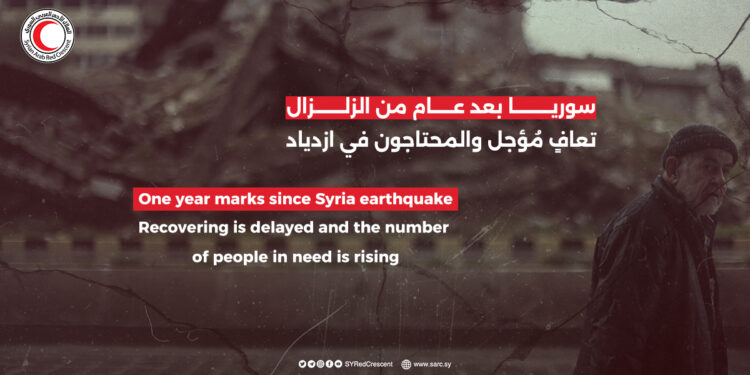The effects of the disaster, which never went away, are evident in the worn-out faces and cracked houses in Syrian towns and cities, but as Yaroub, who now lives in a prefabricated room in Jableh in the countryside of Latakia, puts it, “life gets harder.” His house collapsed due to an earthquake.
Yaroub considers himself fortunate to have survived a certain death, but he is currently unable to support his family financially, particularly concerning his parents’ increasing medical expenses.
A year has passed since the earthquake struck, and many families are still living through the horrific day.
They failed to move past it or make even a small step in the direction of recovery, which led to a lack of adaptation and resistance, which in turn caused further problems, including the economic and humanitarian crises as well as climate change.
When asked why he doesn’t leave his cracked house in the countryside of Latakia,
Mohamed Dayoub responds, “I cannot rent or restore a house.” If the weather worsens, there is a serious risk of rain seeping through the crannied ceiling.
Mohamed is just one of the 8 million people affected by the February 6 earthquake. This figure highlights the size of the disaster, the brittleness of the areas it hit, and the vulnerability of the communities hosting the thousands of displaced families. It only took a few minutes for their attempts to recover to fall apart.
After being forced to flee Jisr al-Shughur in Idlib,Abu Mohamed (a pseudonym) says, “The possibility of our return has become almost impossible, and whoever was not harmed by the crisis was harmed by the earthquake.”
But as the financial crises continued, he lost everything he owned, including his savings, and barely his salary pays for food and drink. At sixty years old, he is too old to take any further action beyond meeting his friend, who was uprooted from Aleppo, by the sea, and sharing worries.
From the first moments of the earthquake, which resulted in approximately 17,000 deaths and injuries, thousands of displaced people, and the destruction or damage of 123,226 buildings, the Syrian Arab Red Crescent acted. Volunteers made every effort to lessen the impact on those affected, from aiding in victim rescue to offering emergency medical attention and physical therapy.
Over 23.5 million humanitarian services were provided, including cash assistance, livelihood support, psychological and legal support, shelter and relief services, and the rehabilitation of vital services.
However, there were enormous needs because the disaster struck a society where 90% of people live below the poverty line and where 15.3 million people needed assistance to meet their most basic needs.
By 2024, that number had increased to 16.7 million people.
“My daughter had pneumonia and needed hospitalization and a lot of medication, so I spent most of it on her treatment,” says Dima,
one of those affected who received financial aid from the Syrian Arab Red Crescent to fix wall cracks in her house in Aleppo and purchase winter clothing for her kids. and a few necessities for the home.
The mother, the sole breadwinner to three children (the eldest is five years old), rearranged her priorities when her daughters fell ill frequently. It was suspected that the pollution from burning firewood for warmth was the source of the illnesses.
She delayed the idea of restoring her cracked house for anonymous timing.
Despite the significance of mental health, many impacted have found that it is secondary to their basic needs.
A year after the earthquake, according to one of the Syrian Arab Red Crescent volunteers working in psychological support, the families’ circumstances have not improved, and many of them were forced to live with their relatives and seek assistance, which has increased their psychological distress.
They are having a harder time overcoming cases of shock, anxiety, depression, and other disorders, which have increased significantly.
What truly frightens Syrians today is the loss of hope, with the deterioration of economic conditions, the doubled cost of living, and the inadequate funding for humanitarian aid.
Their future is uncertain, and they are therefore vulnerable to any crisis, no matter how minor.


